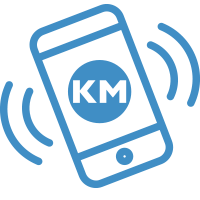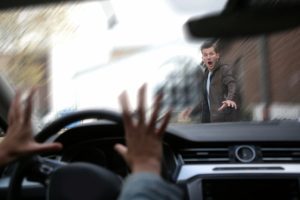Live Help NOW  317-569-9644
317-569-9644
Pedestrian Accident Lawyers in Indianapolis
If a vehicle hit you or a loved one in Indianapolis, the lawyers at Klezmer Maudlin, P.C. can fight for your rights and help you pursue maximum compensation. Pedestrian accidents often result in serious injuries, and you should not have to pay the consequences when someone else is at fault.
We offer free consultations and can review the circumstances of your accident, determine who you can hold liable, and assess the value of your case. Together, our attorneys have over 100 years of experience fighting for injured people and helping them recover.
Contact Klezmer Maudlin, PC, today to speak with an experienced Indianapolis pedestrian accident lawyer for free.
The Pedestrian Accident Crisis
 The number of accidents involving pedestrians in Indianapolis has climbed dramatically in recent years, despite COVID reducing the number of people and vehicles on the streets. WRTV recently reported that Indianapolis is one of the most dangerous places in the country for pedestrians and enumerated several recent crashes.
The number of accidents involving pedestrians in Indianapolis has climbed dramatically in recent years, despite COVID reducing the number of people and vehicles on the streets. WRTV recently reported that Indianapolis is one of the most dangerous places in the country for pedestrians and enumerated several recent crashes.
In August, the Indianapolis Police Department reported that vehicles had hit 130 pedestrians. Twenty-one of those people died, nearly double the 11 deaths that occurred in the same eight-month period the year before.
In October, a driver killed a pedestrian in a hit-and-run collision, setting a new single-year record for Indianapolis: 22 pedestrians killed this year.
Those numbers show a steady uptick in pedestrian accidents and fatalities in Indianapolis. Drivers hit more pedestrians on Indianapolis streets yearly than anywhere else in Indiana. According to the Indianapolis Star, while 20 percent of pedestrian deaths in Indiana happen in Indianapolis, only 13 percent of the state’s population lives here.
The Star also reported that accidents accounted for 148 pedestrian deaths in Indianapolis over the last five years—41 more than the 107 killed in the preceding 5-year period and nearly double the 78 killed in the five years before that. In other words, drivers hit and kill 30 pedestrians annually in Indianapolis, and the numbers are on the rise.
However, the problem extends far beyond Indianapolis. According to the Governors Highway Safety Association (GHSA), pedestrian fatalities across the nation hit their highest level in 40 years in 2021, a number the GHSA expects to increase again in 2022. In 2021, American drivers hit and killed 7,485 pedestrians—an average of 20 people killed every day. Perhaps most frightening, the number of accidents involving children under 15 during daylight hours increased, and many accidents occurred away from schools and other areas with adult supervision.
The GHSA blamed the increase primarily on the proliferation of dangerous driving habits like speeding and impaired or distracted driving. It also found cities lack adequate infrastructure and funding to make streets safer for pedestrians. As a result, streets remain designed primarily for vehicles and speed, not pedestrian safety. Meanwhile, an NBC investigation found that larger vehicles with commensurately bigger blind spots also contributed to the rise in fatal collisions, especially those involving children.
However, some states successfully improved pedestrian safety using the holistic Safe System approach. The system addresses five elements to protect pedestrians and other road users: safe people, safe roads, safe vehicles, safe speeds, and post-crash care. The GHSA strongly advocates that more states implement the Safe System to curb the pedestrian accident crisis.
Where Are Pedestrian Accidents Most Likely?
While many assume that pedestrian accidents are most common in dense urban areas, the GHSA reports that 60 percent of pedestrian fatalities happen on high-speed arterial roads, meaning wide multi-lane roads other than freeways. These surface-level roads carry heavy traffic at high speeds, but pedestrians often need to walk along or cross them.
However, cities space intersections with crosswalks far apart on arterial routes because intersections slow vehicular traffic, giving these pedestrians few places to cross safely. Most vehicle-versus-pedestrian incidents happen away from the intersections, where drivers do not expect people to cross.
Critics argue intersections and other opportunities for pedestrians to cross safely are often too far apart, prompting pedestrians to take their chances crossing multiple lanes of high-speed traffic. Sidewalks provide some protection, but adding crosswalks and slowing vehicle speed limits works better. In addition, because three-quarters of fatal pedestrian accidents happen after dark, improving street lighting can help drivers see people trying to cross the road.
The problem extends beyond these arterial surface roads, however. Freeways with restricted pedestrian access accounted for 17 percent of pedestrian fatalities. The GHSA recommends Move Over laws that require motorists to slow down or change lanes when approaching stopped vehicles to reduce the number of stranded motorists, police officers, and construction workers killed alongside roadways.
Hot Spots for Pedestrian Accidents in Indianapolis
A local Indiana group called Health by Design released a list of the ten most dangerous spots for a pedestrian to walk in Indianapolis.
The areas that saw the most accidents involving pedestrians over a five-year period include:
- West 86th Street between and including parts of Michigan and Harcourt Roads
- West 34th and 38th Streets between Moller Road and 465, including parts of Moller and High School
- West 38th Street between Boulevard Place and Meridian Street
- East 38th Street from the Indiana State Fairgrounds to Sherman Avenue
- Dr. Martin Luther King Jr. Street from 25th to 30th streets
- Meridian and Illinois Streets from 14th to 34th streets, including parts of 16th, 28th, 29th, 30th, and 32nd Streets
- West 10th Street between Tibbs Avenue and Dr. Martin Luther King Jr. Street
- East 10th Street between Woodruff Place and Arlington Avenue
- West Washington St. between Holt Road and 465, including parts of Oliver Avenue and Morris Street
- East Washington Street between Willard Park to Arlington Avenue, including parts of Michigan, New York, and Rural Streets, and Emerson Avenue
Safety Tips for Pedestrians
The National Highway Transportation Association (NHTSA) recommends how drivers can avoid hitting pedestrians:
- Do not use a cell phone or engage in other distracting habits while driving.
- Watch for pedestrians in poorly lit conditions, especially after dark or in bad weather.
- Watch for pedestrians walking in unexpected places and crossing between intersections.
- Always stop for pedestrians using crosswalks and for crosswalk indicators.
- Never enter or turn across a crosswalk when pedestrians have the walk signal.
- Do not go around vehicles stopped at crosswalks. Assume they stopped to allow pedestrians to cross the street.
- Never block the crosswalk when stopping at intersections. Stop farther back so pedestrians can use the crosswalk without stepping in front of oncoming traffic to get around your vehicle.
- Look for pedestrians before pulling out of side streets or driveways. Do not block the sidewalk or the path where pedestrians must walk. Stop farther back so pedestrians can use sidewalks and cross streets without stepping into traffic.
- Never drive under the influence of alcohol or drugs that impair your ability to operate a vehicle.
- Obey the speed limit and slow down near pedestrians, especially in school and work zones.
- Use extreme caution driving where children may be nearby, especially near school zones and parks and in residential neighborhoods.
- Watch for children running into the street from between parked cars or bushes.
Who Is Responsible for a Pedestrian Accident?
In some cases, drivers who hit pedestrians argue the pedestrian caused the accident, typically by jaywalking or crossing the street without an intersection or crosswalk. But a pedestrian crossing the street at the wrong spot or time does not necessarily relieve drivers of their responsibilities.
Someone speeding, texting, or driving after drinking alcohol would retain fault for the accident, even if the pedestrian crossed the road unexpectedly. An attorney can help you hold a negligent driver accountable even if you arguably contributed to the pedestrian accident in some way.
But what if the driver fled the scene? Drivers who hit pedestrians often drive off to avoid arrest. Sometimes police can identify and find hit-and-run drivers from traffic camera footage or testimony from eyewitnesses. An attorney can locate additional cameras in businesses and residences that may have recorded the vehicle leaving the area and interview bystanders to help track down a hit-and-run driver. In addition, an attorney can help determine if someone other than the driver may share fault for the accident.
Sources of Compensation for a Pedestrian Accident
After a pedestrian accident, you may need to focus on getting medical treatment and recovering from your injuries, not hunting for a hit-and-run driver and dealing with uncooperative insurance companies. Let an accident attorney handle your case while you focus on your recovery.
An attorney can identify additional parties who might be liable for the accident. Don’t assume that the driver’s insurance is the only potential source of compensation. You may have personal injury protection as well as uninsured or underinsured motorist protection on your own policy. If you don’t have auto insurance, check your homeowners’ or renters’ policy for personal injury protection. Don’t just take the insurance company’s word on what your policy does and doesn’t cover.
If the accident occurred on private property like a grocery store parking lot, the owner of that property could also hold liability. An attorney can help determine if owners could have prevented the accident and have insurance that covers the accident.
If the accident occurred on a public Indianapolis roadway, an attorney could also investigate whether the city might be liable. Because of the increasing number of pedestrian accidents, Indianapolis residents urged the city to make safety improvements. If another accident occurs on a roadway without sidewalks, crosswalks, or intersections where pedestrians may safely cross, an attorney could argue the city should have made improvements that would have prevented the accident, especially if pedestrian accidents happened there before.
Finally, if the accident occurred near a school or work zone or another location where there may be a duty to protect pedestrians, an attorney can determine whether those responsible provided adequate protection. Schools must keep children safe not only on their grounds but in nearby school zones where children walk to and from class. Likewise, cities and counties must keep roadway and law enforcement workers safe from passing vehicles. An attorney can investigate the circumstances of your accident to determine whether parties other than the driver may share responsibility for the accident.
When to Call Our Attorneys After a Pedestrian Accident
If a driver hits you or a loved one while walking, contact the Indianapolis pedestrian accident lawyers at Klezmer Maudlin, PC, as soon as possible at (317) 569-9644. We offer free consultations and can evaluate your case, determine who may be responsible, and help you maximize the compensation you could recover for the accident.
Our attorneys have over 100 years of combined experience fighting for injured people and helping them get compensation and accountability. Contact us today to discuss your case with an Indianapolis personal injury lawyer.
Testimonial
“Attorney Maudlin was excellent. He was diligent and thorough and kept me updated. Shelly in the office was excellent at gathering all the documents and information she needed for my case. Great team effort. Thank you all for your long and hard work.”-Teresa Brown
Klezmer Maudlin Indianapolis Office Location
8520 Center Run Dr
Indianapolis, IN 46250
317-597-6293
We respect your privacy. All of the information you provide will be kept strictly confidential. After you submit the contact form below, we will follow up with you – usually within 24 hours and sometimes much sooner than that. We are prepared to answer all of your questions and provide you with advice about your legal options during a free consultation and claim review.
Follow Us

